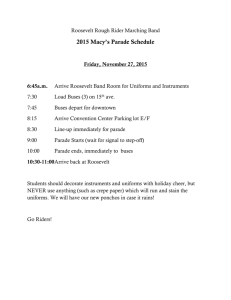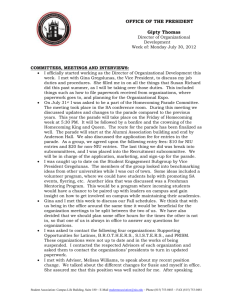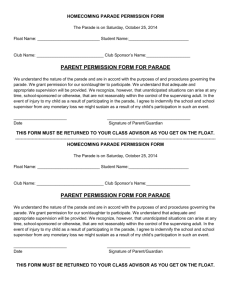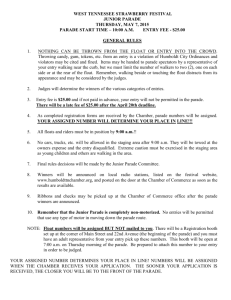determination - Parades Commission
advertisement
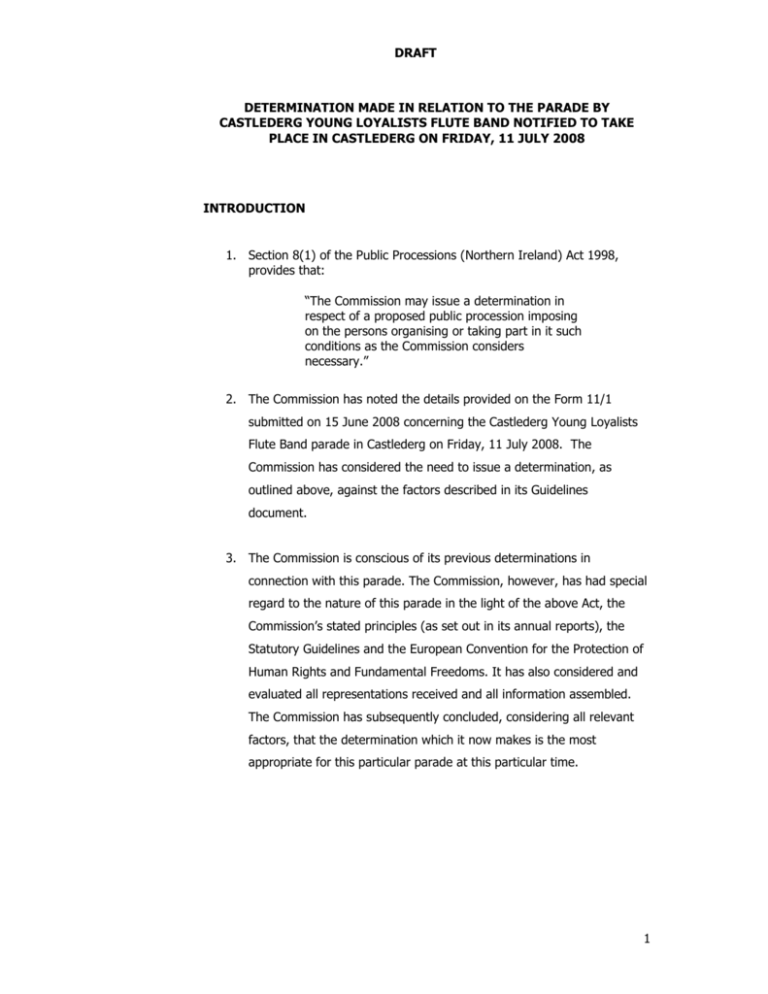
DRAFT DETERMINATION MADE IN RELATION TO THE PARADE BY CASTLEDERG YOUNG LOYALISTS FLUTE BAND NOTIFIED TO TAKE PLACE IN CASTLEDERG ON FRIDAY, 11 JULY 2008 INTRODUCTION 1. Section 8(1) of the Public Processions (Northern Ireland) Act 1998, provides that: “The Commission may issue a determination in respect of a proposed public procession imposing on the persons organising or taking part in it such conditions as the Commission considers necessary.” 2. The Commission has noted the details provided on the Form 11/1 submitted on 15 June 2008 concerning the Castlederg Young Loyalists Flute Band parade in Castlederg on Friday, 11 July 2008. The Commission has considered the need to issue a determination, as outlined above, against the factors described in its Guidelines document. 3. The Commission is conscious of its previous determinations in connection with this parade. The Commission, however, has had special regard to the nature of this parade in the light of the above Act, the Commission’s stated principles (as set out in its annual reports), the Statutory Guidelines and the European Convention for the Protection of Human Rights and Fundamental Freedoms. It has also considered and evaluated all representations received and all information assembled. The Commission has subsequently concluded, considering all relevant factors, that the determination which it now makes is the most appropriate for this particular parade at this particular time. 1 DRAFT BACKGROUND 4. The Commission notes that purpose of this parade is “Pre 12th July Celebrations”. It is aware of the concerns associated with parading in Castlederg. CONSIDERATION 5. The Commission is obliged by statute to have regard to the Guidelines issued under Section 5 of the Public Processions (Northern Ireland) Act 1998 and has done so. The Commission has also been alert to its duties as a public authority under Section 6 of the Human Rights Act 1998. The Commission believes that, from the perspective of the parade organisers, the Convention rights engaged are those protected by Articles 9 and 10 and, in particular, Article 11. None of those rights is absolute. 6. Further, the human rights of other persons, to whom the Commission also owes a legal duty, must be equally considered. Those who live, work, shop, trade and carry on business in the affected locality enjoy rights under Article 8 of the Convention and Article 1 of the First Protocol thereto. In common with Articles 9, 10 and 11, none of these rights is absolute. The Commission has also been mindful to take into account its positive obligations under Article 2 of the Convention. Similarly it has been mindful of the provisions of Article 17 of the Convention. 7. It is not possible for all of those who would claim the benefit of the Human Rights Act 1998 to exercise and enjoy their Convention rights to the fullest extent, where rights are in competition with each other. The Commission, therefore, has had to undertake a balancing exercise, bearing in mind the statutory Guidelines, in an attempt to reach a determination which is fair and proportionate in all the circumstances. In addition to having regard to the Guidelines the Commission has had regard to the criteria specified in Section 8(6) of the Public Processions (Northern Ireland) Act 1998. 2 DRAFT 8. The Commission has also had regard to the issue of engagement. One of the seven fundamental principles identified by the North Report is that all those involved should work towards resolution of difficulties through local accommodation. As required by the statutory Guidelines, the Commission has had regard to the seven North principles. 9. As indicated at page 15 of its second Annual Report, the Commission (while avoiding an excessively prescriptive approach) considers the essence of engagement to be attempts at genuine communication between protagonists to a particular parading dispute. A series of “pointers” to what constitutes genuine engagement is listed on page 16 of that report. 10. As stated in paragraph 4.4 of the Guidelines, the Commission takes into account any communications between parade organisers and the local community or the absence thereof. Further, the Commission will assess the measures, if any, offered or taken by parade organisers to address genuinely held relevant concerns of members of the local community. 11. In the present case the Commission is not aware of any meaningful engagement having taken place with local representatives. 12. The Commission has also taken into account the possibility that if a large-scale policing operation is required the disruption to the local community and the possible infringement of protected Convention rights will increase commensurately. 13. The Commission has had regard to the nature of this parade, the purpose of which is described earlier in the determination. 14. Having considered all the evidence, information and advice available to it, the Commission takes the view that it is necessary to curtail part of the parade’s notified route, and it has therefore placed conditions on the parade. This decision is set against the background of continuing local community tension. It recognises the real possibility of damaging 3 DRAFT community relations with a consequent effect on the likelihood of public disorder should the parade proceed along the entirety of its notified route. Whilst recognising the fundamental importance of the right to freedom of assembly, the Commission finds it necessary to exercise its powers under section 8 of the Public Processions (Northern Ireland) Act 1998 to place restrictions on the parade. 15. In fulfilling these conditions, the Commission pursues the legitimate aims laid down in Article 10(2) and 11(2) of the European Convention for the Protection of Human Rights and Fundamental Freedoms, of seeking to prevent disorder and to protect the rights and freedoms of others. 16. In determining whether the conditions are necessary in a democratic society and proportionate, the Commission has regard inter alia to the criteria set down in section 8(6) of the Public Processions (Northern Ireland) Act 1998 and to its own Guidelines made under section 5 of the Act and to which under section 8 (5) it shall have regard when making a determination. 17. Having regard to the factors set out above the Commission considers that the conditions it now imposes are necessary and proportionate to the aim pursued. The conditions are not such as to affect significantly the individual’s right to assemble. The Commission believes that the conditions it imposes strike a fair balance between the needs of the community and the rights of the individual. 4 DRAFT DETERMINATION The Parades Commission’s determination is that the following conditions are placed on the organiser and participants in the parade by Castlederg Young Loyalists Flute Band in Castlederg on Friday, 11 July 2008. A. No music other than a single beat played on a single side drum shall be played between the junction of High Street and Priest’s Lane, and the junction of Ferguson Crescent, Thomas Street and Castleview Terrace at any point during the parade. B. No supporters shall accompany the parade on that part of the notified route between the junction of High Street and Priest’s Lane, and the junction of Ferguson Crescent, Thomas Street, and Castleview Terrace at any point during the parade. C. Only the band notified on the Form 11/1 shall participate in the parade. D. When the parade is in progress there shall be no undue stoppages or delays. Where practicable the parade shall stay close to the near side of the road at all times to minimise disruption and to facilitate the passing of vehicular and other traffic. E. The organiser shall arrange for the presence of an adequate number of stewards to ensure that all parade participants act in an orderly manner. F. The parade organiser shall bring to the attention of stewards the guidance for parade participants contained in Appendices A and B of the Commission’s Code of Conduct. For ease of reference Appendices A and B are reproduced below. 5 DRAFT G. The parade organiser shall ensure that all stewards and participants obey any direction given by the police in relation to this parade. H. The parade organiser shall ensure that these conditions are drawn to the attention of all participants. Signed: ………………………………………… (On behalf of the Commission) Date: ………………………………………… 6 DRAFT APPENDIX A Guidance for Anyone Participating in Parades A. Behaviour All participants in parades should: behave with due regard for the rights, traditions and feeling of others in the vicinity; refrain from using words or behaviour which could reasonably be perceived; as being intentionally sectarian, provocative, threatening, abusive, insulting or lewd; obey the lawful directions of parade organizers and stewards at all times, from assembly to dispersal; abide by the conditions of this Code of Conduct; and comply with police directions and in accordance with legislation. B Dress No paramilitary-style clothing is to be worn at any time during a parade. C Parade Whenever possible, the parade should be positioned on one side of the carriageway so as to allow for the free flow of traffic, or as otherwise stipulated by police. D Route Participants should keep to the designated route as directed by the police. E Alcohol Alcohol should not be consumed immediately prior to, or during a parade. An organizer or steward, who believes a participant to be under the influence of alcohol, should take the necessary measures to remove that person from the parade. F Bands and Music Each band must clearly display its name. Restrictions on the playing of music will be in accordance with the conditions as set out in Appendix B of this Code. 7 DRAFT No musical instrument will bear any inscription or mark of a proscribed organization. G Flags etc. Flags and other displays often have a legitimate historical significance, but in no circumstances should such items relating to a proscribed organization be displayed. H Stewards The names of stewards will have been notified to the police and the Parades Commission at the time of notifying the proposed parade. Stewards should: be properly trained; be briefed by the organizers prior to the parade; carry proof of their status at all times during the event, and provide this information to police on request; be fully aware of their responsibilities and role; be highly visible by means of jackets, singlets, armbands, etc; not consume alcohol before or during the parade; co-operate with the police; and be prepared to identify to the police any persons in the parade who may be committing any offence against criminal law. I Policing Organisers of parades must co-operate with the police from the time of submission of the notice of intention to parade until the parade disperses. J Dispersal When a parade has concluded, all those taking part must disperse immediately. It will be the responsibility of the organizers to ensure compliance with instructions in this regard. K Abiding by Conditions Organisers must ensure that all participants in any parade have been informed of any conditions imposed. As a general principle, the organiser is responsible 8 DRAFT for the behaviour of all participants and for ensuring compliance with the Code of Conduct. 9 DRAFT APPENDIX B Guidance for Anyone Participating in Parades in the Vicinity of Sensitive Locations A Places of Worship Only hymn tunes should be played. When church services are taking place, no music should be played. There should be no irreverent behaviour. Marching should be dignified. B War Memorials and Cemeteries Only hymn tunes should be played. Behaviour should be respectful. Marching should be dignified. C Where the Majority Population of the Vicinity are of a Different Tradition, and in Interface Areas. Behaviour should be respectful. There should be no excessively loud drumming. Participants should refrain from conduct, words, music or behaviour which could reasonably be perceived as intentionally sectarian, provocative, threatening, abusive, insulting or lewd. Marching should be dignified. 10

